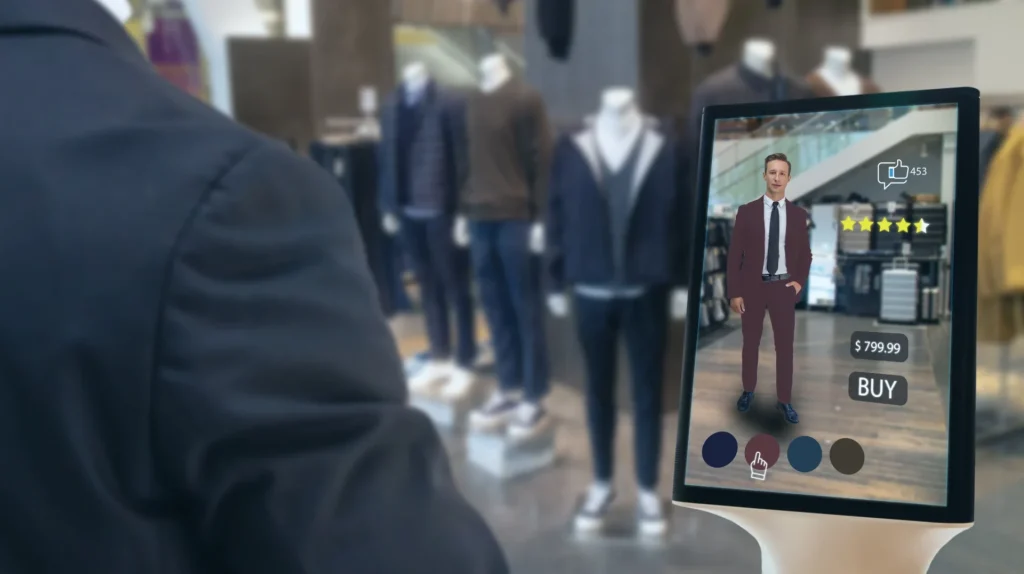AR In eCommerce: The Game-Changer For Online Shopping
Augmented Reality (AR) has a profound impact on eCommerce, making shopping more hands-on and lifelike. Experts predict that by 2027, 98% of leading retailers will use AR. The market is set to hit $18.1 billion by 2026, with a growth rate of 27.3% each year. AR allows customers to see products in real time, which cuts down on uncertainty, lowers the number of returns, and boosts buyer trust. From clothes to furniture, AR closes the gap between online and in-store shopping, making internet purchases more fun and trustworthy. As more businesses adopt AR, it’s on track to change how we shop online in the future.
Don’t miss out on the next big shift in eCommerce. Explore AR-powered shopping now and enjoy a more interactive, confident, and hassle-free buying experience. Try it today and see your favorite products come to life before you buy.
Transformative Impact Of Augmented Reality
Augmented Reality has an impact on our interactions with digital platforms. It brings virtual components into the real world, enhancing shopping, learning, healthcare, and entertainment. Online shopping lets buyers see items before making a purchase, which boosts their trust and cuts down on guesswork. In schools, It makes lessons more fun with 3D models you can interact with. Doctors and nurses use XR to help with operations, find health issues, and learn new skills. As AR keeps growing, it’s set to cause a revolution in many fields, making experiences more lifelike and productive.
Ready to experience the power of AR? Explore Its Possibilities Today and step into the future.
12 Game-Changing Benefits Of AR In Online Shopping
AR is changing the concept of online shopping. It creates lifelike buying experiences that make customers happier and increase sales. When online stores use XR tech, they close the gap between buying on the internet and in stores, making purchases more fun and trustworthy. Here are the 12 main perks of augmented Reality in online purchasing and how businesses can use them well.
1. Enhanced Product Visualization
Not being able to see, feel, or try products before buying is one of the biggest problems with online shopping. XR fixes this by showing 3D views of products. Shoppers can look at items from all sides, zoom in to see small details, and even check how they’d look in their homes. This real-world-like experience helps buyers make smart choices and cuts down on uncertainty.
Best Practices
- Implement AR integration for detailed product visualization
- Offer interactive shopping features like Zoom, rotate, and customization options
- Use mobile AR applications for seamless product previews
2. Increased Customer Engagement
AR-powered experiences hold customers’ attention for longer periods by turning shopping into a fun interactive activity. Tools like virtual fitting rooms, three-dimensional models, and AR product demonstrations create an all-encompassing shopping environment that grabs interest and prompts exploration. The more a customer engages, the higher the chance they’ll buy something.
Best Practices
- Introduce virtual try-ons for fashion, beauty, and accessories
- Provide gamified AR experiences for increased customer engagement
- Develop immersive product demonstrations through AR app development
3. Reducing Return Rates
Online stores struggle with product returns, which cause high expenses and shipping headaches. XR tech helps cut down on returns by showing realistic product previews so customers know what they’re getting. Features such as 3D product views and live size guides reduce mismatches and letdowns, resulting in fewer returns.
Best Practices
- Enable 3D product previews to match expectations
- Offer personalized shopping experiences with real-time product testing
- Use AR-powered size guides and product fit tools
4. Cost-Effective Marketing
Old-school marketing can cost a lot, but AR tech offers a budget-friendly way to connect with customers through hands-on unforgettable experiences. Companies can develop XR ads, product demos, and social media filters that get users to interact and share, boosting organic reach and brand recognition.
Best Practices
- Utilize AR app development for interactive product showcases
- Encourage social media sharing of AR integration experiences
- Create branded augmented reality filters for social platforms
5. Expanding Market Reach
Augmented Reality allows businesses to connect with more people by making shopping easier and more convenient. Whether customers shop from their couch or while out and about mobile AR apps let them interact with products in real-time. This makes online purchasing more welcoming and attractive to shoppers worldwide.
Best Practices
- Offer immersive shopping experiences in multiple languages
- Integrate mobile XR applications to reach smartphone users worldwide
- Leverage AR-powered ad campaigns for cross-border sales
6. Enhancing Brand Image
The implementation of XR technology allows brands to display their innovative stance, which leads to credibility growth and the attraction of technology-oriented customers. Organizations that implement MR integration understand the importance of exceptional customer experiences while providing excellent shopping solutions.
Best Practices
- Develop high-quality AR app development solutions for brand exclusivity
- Offer cutting-edge AR integration for unique shopping experiences
- Highlight customer success stories and testimonials using AR
7. Personalized Shopping Experiences
Consumers currently look for custom shopping experiences, while AR technology provides them with exactly what they desire. Augmented reality technology analyzes user preferences to produce individualized product recommendations that help customers discover relevant items more efficiently. Companies experience better customer satisfaction and enhanced brand loyalty through personalized shopping engagements.
Best Practices
- Implement AI-driven AR integration for customized recommendations
- Allow users to create personalized virtual try-on
- Track customer behavior to enhance interactive shopping
8. Interactive Customer Support
Real-time troubleshooting and assistance through MR technology advances consumer service. Businesses can leverage augmented reality technology to provide interactive visual guidance instead of slow text-based instructions, which will lead to enhanced efficiency and easier user experiences.
Best Practices
- Use AR app development for step-by-step product setup
- Provide real-time interactive shopping assistance via XR chatbots
- Offer AR-powered self-service guides for customers
9. Improved Shopping Experience
Through virtual interaction in online purchasing, AR boosts the complete customer shopping process. Mobile XR applications let consumers view products through interactive experiences that help them become more satisfied and trust online businesses more.
Best Practices
- Enable mobile AR applications for a seamless shopping journey
- Integrate AR-powered smart mirrors for fashion and beauty brands
- Develop eCommerce trends that enhance customer satisfaction
10. Boosting Sales And Conversion Rates
Online conversion rates rise when customers benefit from XR applications which enable them to reach confident buying decisions. Product visualizations in real-world environments enable customers to buy more merchandise which reduces shopping cart dropouts while producing greater revenue streams.
Best Practices
- Offer virtual try-ons to enhance buyer trust
- Implement 3D product previews for high-value items
- Use AR integration to create a seamless checkout experience
11. Competitive Advantage In eCommerce Trends
The strong advantage in competition goes to businesses that start using AR technology at its current growth period. Organizations implementing AR business solutions establish market supremacy because their innovative immersive shopping solutions appeal directly to present-day customers.
Best Practices
- Invest in AR-powered features that competitors lack
- Continuously update XR applications with new shopping features
- Educate consumers on the benefits of AR-powered shopping
12. Future-Proofing Online Retail
It is AR that drives future development in online retail so businesses which adopt this technology will lead their industry. The evolving trends of eCommerce will establish AR technology as an essential element of digital shopping so organizations that adopt it today will gain advantageous market positions.
Best Practices
- Stay updated with advancements in AR app development
- Test and implement the latest AR integration techniques
- Focus on sustainable, scalable AR solutions for long-term growth
What Are The Applications Of Augmented Reality In eCommerce?
Augmented Reality (AR) changes online shopping through its ability to create interactive product experiences that make connections between virtual and physical retail possible. Customers gain real-time product interactions through AR technology to increase engagement levels and build confidence and satisfaction. The following illustrates key examples of how Augmented Reality transforms eCommerce operations.
Virtual Try-Ons
Shopping online becomes difficult since customers cannot engage with goods before making a purchase. Virtual try-ons utilize AR technology to provide real-time visualizations of clothing accessories, makeup, and eyewear that work with individual customers’ appearances. This feature boosts customer engagement and reduces return rates. It does this by providing accurate style and sizing results.
Key Benefits
- Enhances personalized shopping experiences
- Reduces guesswork and increases buyer confidence
- Minimizes product returns by offering real-time visualization
AR Product Demos
Online product demonstrations function as the key method for displaying product capabilities to customers. AR product demos let customers see products from different angles. They can explore features and watch how they work in real-life situations. The app is great for showing off electronics, appliances, and complex machines.
Key Benefits
- Provides an interactive shopping experience
- Helps customers understand product functionality before purchasing
- Increases conversion rates by building trust and confidence
Virtual Showrooms
Virtual showrooms offer customers a rich digital space. Here, they can explore products and engage with them. The application is popular in furniture, automotive, and luxury retail. Customers can see 3D previews of products in their homes. They can also browse complete catalogs.
Key Benefits
- Creates a highly immersive shopping experience
- Allows customers to explore products in their real environment
- Enhances brand image and customer satisfaction
AR Navigation In Stores
Storefronts achieve enhanced customer navigation through AR by utilizing smartphones to guide shoppers directly to access desired products or store areas. Real-time directions combined with product details and customized recommendations improve customer interaction through this feature, which boosts shopping efficiency.
Key Benefits
- Improves in-store navigation and convenience
- Enhances customer engagement with real-time assistance
- Encourages seamless integration between online and offline shopping
Boost Sales With AR: Integrating Augmented Reality Into Your Ecommerce Platform
Augmented Reality implementation within eCommerce platforms boosts both customer engagement and conversion rates while producing highly interactive shopping environments. The following guide demonstrates how to integrate AR technology into your online store through simple steps:
- Identify how AR technology can enhance product visualization, such as virtual try-ons and 3D product previews.
- Choose the right AR platform, like WebAR, mobile AR applications, or third-party solutions such as Shopify AR and ARKit.
- Develop or integrate an AR app to offer interactive shopping experiences and seamless AR integration.
- Optimize product images with high-quality 3D product previews for smooth and realistic interaction.
- Ensure mobile compatibility for better accessibility and a seamless, immersive shopping experience.
- Promote AR features through product listings, social media, and email marketing to boost customer engagement and conversion rates.
Want To Transform Your Online Store With AR – Webo 360 Solutions Can Help
You need Augmented Reality technology to upgrade your online store. Webo 360 Solutions is your top AR partner. We create exciting AR solutions that boost customer interactions and increase conversions. Our goal is to craft unique shopping experiences. Our expert team develops AR apps and virtual try-on features. We create 3D product displays and interactive shopping tools. Users can experience products in exciting new ways. We design tailored AR solutions for a range of industries. These sectors include fashion, beauty, furniture, and electronics. You can stay ahead in the eCommerce market. This lets customers engage with your products with confidence.
Ready to transform your online store? Contact Webo 360 Solutions Today and elevate your brand with next-level AR technology.
Conclusion
Augmented Reality in eCommerce offers fun shopping experiences. It lets customers try on items virtually. This feature draws in shoppers and helps increase sales. AR technology helps businesses blend online and in-store shopping. This makes shopping easier and more fun for customers. Current trends in eCommerce development will depend heavily on AR technology for future retail innovations.
Enhance customer engagement and boost conversions with AR.




